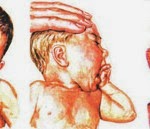The peroneals pull the foot out and the post tib pulls the foot in. Together they help to keep the foot level so that the ankle can move through it’s full range of motion and the big muscles of the calf and upper leg can propel you forward off of your big toe. This is important! If there is a limitation in the ankle (either the joint itself is tight or your calves are tight or your big toe doesn’t extend all of the way), this mechanism will not work. The only way to keep yourself moving forward is to rotate the foot in or out. The same goes for the other end of the leg chain- the hip. If you can’t extend your hip all of the way and push off using the glutes, you end up with a short stride that doesn’t give the ankle enough time to move through it’s motion. The body will compensate by rotating that leg so that you don’t fall over your own two feet. If your motion seems fine in the ankle and hip and you’re still getting this- time to look at your shoes. Too much/too little support can have the same effect!
In this picture you can see how the foot twists out and effectively twists the whole leg. When this happens the peroneals can get cooked because now they are getting loaded with every step and trying to shock absorb and then push off instead of the gastroc/soleus. These are skinny little muscles that aren’t designed to handle that. Over time they will break down.
In this picture you can see how the foot twists in. Again, the whole leg twists to compensate for this. Here the posterior tibialis takes on the increased work load of shock absorbing and then trying to push off. The problem for the peroneal is that it is repetitively stretched out when this happens. The tendon can get irritated or the muscle itself trying to pull it back to it’s neutral position.
So what’s the take away from all of that? This is one of those injuries where you have two things to fix: 1) the injured muscle, and 2) the mechanism that caused it (tight ankle, tight calf, big toe, or tight hip). If you only fix the muscle, this will haunt you for a long, long time. Take the time to get to the root of the problem.
The outside of my calf hurts? NOW WHAT?
1) The first step is determining if it is truly a peroneal injury or something else. Remember, the goal of this series is not to keep you away from your doctor so that you can self treat everything. It’s to teach you how to catch the early symptoms and take care of them before it becomes a full blown injury. That being said, peroneal injuries can start as a gradual ache/pain during workouts or even after. It can also be one of those injuries where nothing is wrong until you sit down and stiffen up. Then all of the sudden- ouch!
Typical symptoms with peroneal injuries include pain or tightness on the outside of the calf just below the level of the knee cap. They can move all the way down the outside of the calf to the ankle, as well as, into the bottom of the foot. Symptoms are typically worse with activity and better with rest, and swelling can occur at the lower tendon (between the lateral maleolus and foot) if the inflammation is severe enough.
Here are some guidelines for when seeing a doc should be your top priority: 1) If you see any bruising and/or swelling, and 2) numbness/tingling along the outside of the leg (knee to foot). An injury to the peroneals is a symptom of a bigger problem. Think of it like a link in the chain. Something stopped working and that chain got snapped due to the increased strain on it.






